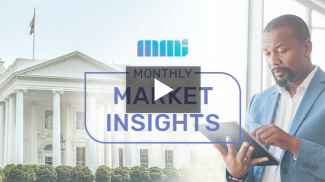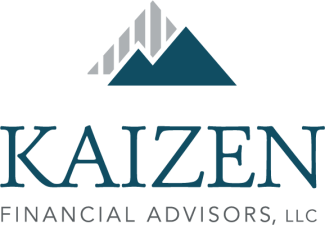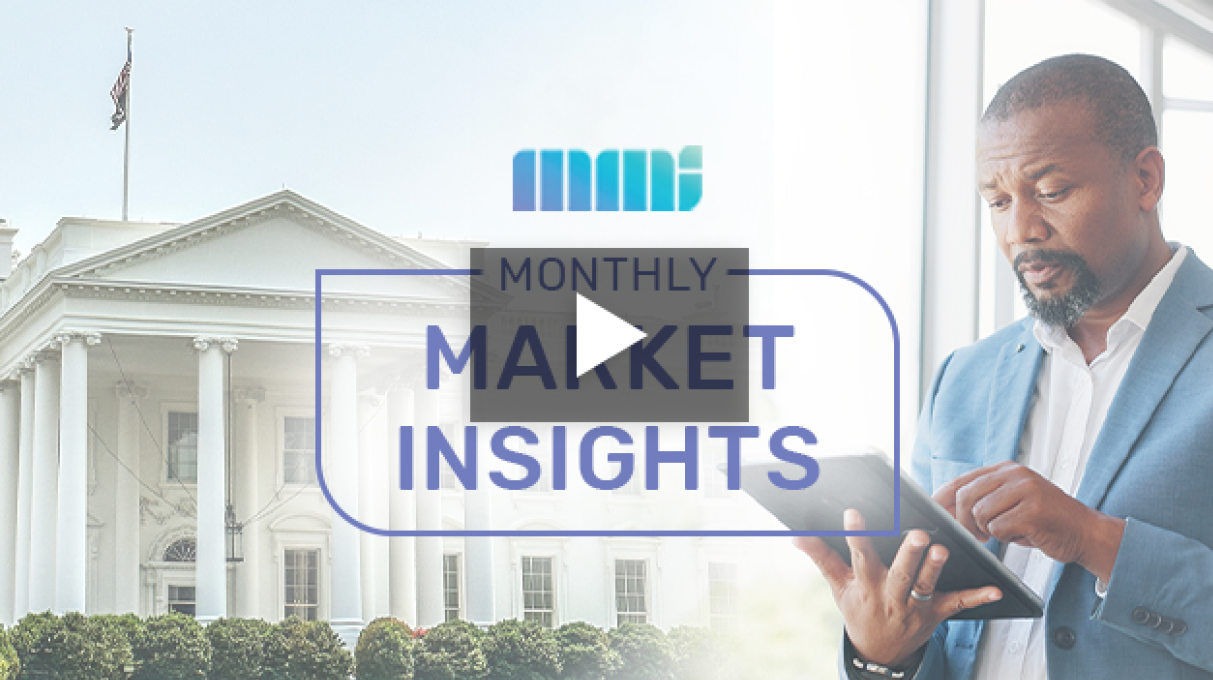
MMI August: Volatility Tests Investors
Stocks edged higher as investors look for clues from the Fed.
U.S. Markets
Stocks edged higher during a volatile month of trading as investors monitored economic reports about the Fed’s next move with short-term interest rates.
The Dow Jones Industrial Average led in July, picking up 4.41 percent. The Standard & Poor’s 500 Index added 1.13 percent while the Nasdaq Composite struggled, slipping 0.75 percent
Fed One Step Closer?
Stocks opened the month strong, supported by a Consumer Price Index report that showed inflation dipped in June. The Personal Consumption Index, an inflation measure closely followed by the Fed, offered additional evidence that inflation was slowing. Some concluded this news may bring the Fed one step closer to adjusting short-term rates
Tech Under Pressure
The rally came under pressure mid-month, however, as investors turned away from technology issues to focus on small-cap names and the Dow Industrials. Investors anticipated that small caps and blue chips would be among the first stock market groups to benefit if the Fed cut short-term rates. The Russell 2000, a barometer for small-cap stocks, gained over 10 percent in July.
Fed Chair Says 'Rate Cut' on the Table
As the month came to a close, stocks regained their momentum in the days leading up to July’s Fed meeting. When Fed Chair Jerome Powell indicated a September rate cut was "on the table," stocks saw a broad-based rally on the last day of trading.
Sector Scorecard
Ten of the eleven S&P 500 sectors finished the month in positive territory, led by Real Estate (+7.24 percent), Financials (+6.40 percent), Utilities (+6.82 percent), Industrials (+4.92 percent), Materials (+4.34 percent), and Healthcare (+2.66 percent).
Also posting solid gains were Energy (+2.25 percent), Consumer Staples (+1.66 percent), Consumer Discretionary (+2.79 percent) and Communication Services (+0.15 percent). The technology sector lost -3.29 percent for the month.
What Investors May Be Talking About In August
In the month ahead, expect attention to continue shifting to the election on November 5.
While much of the attention tends to focus on the presidency, it’s important to remember that 34 Senate races, all 435 House seats, and a host of other state and local initiatives will be on the ballot.
Here are three takeaways to consider:
- Expect the unexpected — Speeches, debates, and other comments from presidential candidates can lead to new information being released. Speculators can overreact to how a proposed policy idea may affect the economy and the financial markets.
- Anticipate market volatility — Historically, September and October have been the most volatile months for stock prices. Mix in some election uncertainty this year, and price swings may again mark September and October.7
- Remember your portfolio — There’s an old saying that goes, "You might care more about the election than your portfolio." Remember that your goals, time horizon, and risk tolerance should guide investment decisions, not election cycles.
World Markets |
|
The MSCI-EAFE Index gained 2.89 percent in July as markets rallied globally. European stocks performed well, with the UK (+1.40 percent), Spain (+1.11 percent), France (+0.45 percent) and Germany (+1.50 percent) notching gains. Pacific Rim markets were mixed. India’s Sensex index rose 3.43 percent while Japan’s Nikkei lost 1.22 percent, and China’s Hang Seng index fell 2.11 percent. |
Indicators |
Gross Domestic Product (GDP)The economy grew 2.8 percent on an annualized basis in the second quarter, exceeding the 2.1 percent expected by economists and doubling the first quarter’s 1.4 percent annualized pace. EmploymentEmployers added 206,000 jobs in June, compared with the 218,000 jobs created in May, which was slightly more than economists expected. The unemployment rate inched up to 4.1 percent, while average hourly earnings rose 3.9 percent year-over-year in June—the smallest wage gain since 2021. Retail SalesRetail sales were unchanged in June, defying economic forecasts that called for a slowdown. Retail sales were supported by increases in a number of areas, including online sales, clothing, and building materials. Excluding autos and gas, retail sales rose 0.8 percent in June. Industrial ProductionIndustrial output rose 0.6 percent in June, higher than the 0.3 increase expected. All three industry groups—manufacturing, mining, and utilities—rose, with consumer goods (particularly autos and energy) contributing the most to the increase. June’s expansion followed a 0.9 rise in May. HousingHousing starts rose 3.0 percent in June from an upwardly revised May pace, led by gains in multifamily starts–especially in the Northeast and Midwest. Year over year, total starts fell 4.4 percent as higher mortgage rates created headwinds for homebuilders. Sales of previously owned homes slumped 5.4 percent in June, marking a gradual shift from a seller’s market to a buyer’s market as inventory finally started to catch up with demand. The median sales price was up 4.1 percent year-over-year to $426,900. New home sales fell 0.6 percent in June, driven by decreases in the Northeast and Midwest. The median new home sales price was $417,300, and inventory was 9.3 months. Consumer Price Index (CPI)Consumer prices declined 0.1 percent in June, better than economists expected. It was the third month in a row that inflation cooled and the first monthly decline since May 2020. Core inflation (CPI minus volatile food and energy prices) rose 0.1 percent in June. Durable Goods OrdersNew orders of manufactured goods designed to last three years or longer declined 6.6 percent in June, compared with May’s 0.1 percent increase. The decline was led by transportation orders. |
The Fed |
|
The Federal Reserve left interest rates unchanged at the 5.25-5.5 percent target range following its two-day meeting that ended on July 31. In its policy statement, the Federal Open Market Committee (FOMC) downgraded its level of concern around inflation, leading some to be more hopeful for a rate move at the September meeting. At the press conference following the announcement, Fed Chair Powell added, "A reduction in the policy rate could be on the table as soon as the next meeting in September. We’re getting closer to the point at which it’ll be appropriate to reduce our policy rate, but we’re not quite at that point." |
By the Numbers: Record Highs & Lows
Prospect Creek, AK -80° - Location in U.S. of the lowest recorded temperature
Needles, CA - Hottest city in the U.S. on average
Fairbanks, AK - Coldest city in the U.S. on average
Death Valley, CA at 134°- Location in the U.S. of the highest recorded temperature
Las Vegas, NV - The driest city in the U.S.
Mobile, AL - The wettest city in the U.S.
$29 billion - The total amount U.S. homeowners spend on air conditioning costs per year
85% - The percentage of U.S. families who escape the summer heat by camping
87% - the percent of U.S. homes with air conditioning
4030 Lake Washington Boulevard NorthEast Suite 308 Kirkland, WA 98033
Check the background of your financial professional on FINRA's BrokerCheck.
The content is developed from sources believed to be providing accurate information. The information in this material is not intended as tax or legal advice. Please consult legal or tax professionals for specific information regarding your individual situation. Some of this material was developed and produced by FMG Suite to provide information on a topic that may be of interest. FMG Suite is not affiliated with the named representative, broker - dealer, state - or SEC - registered investment advisory firm. The opinions expressed and material provided are for general information, and should not be considered a solicitation for the purchase or sale of any security.
Copyright 2024 FMG Suite.
Kaizen Financial Advisors, LLC (CRD No. 155353), is an investment advisor registered with the United States Securities and Exchange Commission. Please note that the use of the term “registered” does not imply any particular level of skill or training. The information contained herein is not an offer to sell or a solicitation to engage us for investment advisory services in any jurisdiction(s) in which we are not appropriately registered, notice filed, excluded, or exempt from registration. Please see our Form ADV Part 2A Firm Brochure and our Form ADV Part 3 Client Relationship Summary for more information regarding our firm and our advisory services. Copies of these documents are available free of charge by searching for our firm by name or CRD number at https://adviserinfo.sec.gov/.
All information, statements, and opinions contained herein have been obtained or derived from sources which we believe to be reliable and accurate. However, we do not warrant or guarantee the timeliness, completeness, or accuracy of any of the same. Past performance is not indicative of future results. Investing in securities involves the risk of loss, including the risk of loss of principal, which clients should be prepared to bear. The information contained herein is for informational purposes only and is not intended as personalized investment advice. You should consult with a financial professional regarding your unique financial needs and limitations before considering any investment.





